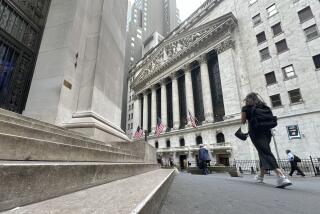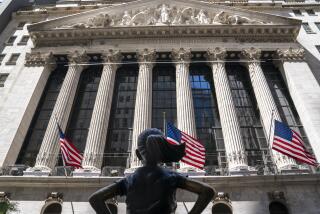Net Frenzy Grows More Acute, as Do History’s Lessons
- Share via
Never before in the history of U.S. securities markets had shareholders owned so many equities with such stratospheric price-to-earnings multiples.”
Another critic of the Internet stock frenzy? Nah. That was financial consultant and author Max Shapiro writing in Dun’s magazine in January 1971.
His article, titled “The Great Crash in Growth Stocks,” was a review of the technology stock mania of 1967-68, which lifted a select group of shares to prices with which Wall Street had no previous experience.
It didn’t last--which, of course, was the basis of Shapiro’s story. Between 1968 and 1970 the top tech stocks of that era collapsed. Then-hot names such as Control Data, Optical Scanning and Mohawk Data all lost more than 80% of their value from their peaks to their troughs.
With today’s Internet stocks, that would be the equivalent of Net directory firm Yahoo plunging from Friday’s record high of $343.63 to less than $69. Or bookseller Amazon.com falling from the $160.25 now to less than $32.
Are declines of that magnitude inevitable with stocks that become so drastically overvalued by all conventional investment yardsticks? History says that most stocks that go vertical--that is, rise nearly straight up in a relatively short time--come down just as dramatically and often just as quickly.
“You’ll buy Amazon.com for under $50 in a year or two,” John McGinley Jr., a market “technician” who publishes Technical Trends newsletter in Wilton, Conn., confidently says.
But here’s the punch line: Many of the same people who have been driving Amazon.com shares up sharply in recent months, along with other Net stocks, probably would agree with McGinley.
By all accounts, the trading in many of these Net stocks now has little to do with earnings projections or other fundamentals. It’s mostly about rapid-fire entry, and exit, by a growing group of individual investors and professional “day traders” whose only goal is to turn a profit by dinner time.
On Friday, Amazon.com traded as low as $152 and as high as $199.13, before ending at $160.25, up $1.38 for the day.
It’s hardly likely that the outlook for the company’s business could have fluctuated so meaningfully in the course of six hours to justify that kind of swing in prices.
“It’s just speculators now,” says Bernard Madoff, head of brokerage Bernard L. Madoff & Co. in New York and president of the Securities Industry Assn.’s trading committee. “They couldn’t care less about the fundamentals of the companies.”
And that would appear to be a crucial difference in this mania compared with others, including the tech craze of 1968: Most of the players today know that the higher they push the stocks, the more likely it is that a crash will follow. There isn’t any pretense about avoiding it; it’s simply every trader’s expectation that they’ll be out the door before everyone else.
Back in 1968, second-to-second electronic trading was just a dream. Indeed, for a time in that era, the New York Stock Exchange had to close on Wednesdays to process the backlog of paper orders.
So even if many of the buyers of those stocks may have been driven largely by the “greater fool” theory--meaning, I may be a fool for paying this price, but a greater fool will come along to pay even more--there still was some fundamental basis to the exuberance over the stocks, and a reasonably long-term view regarding their prospects.
As Max Shapiro wrote in 1971: Investors “did not regard an inflated price-to-earnings ratio as a hindrance because each of the ‘dynamic’ companies in which they invested would soon undergo rapid earnings growth, and this growth would be reflected in the price of the stock.”
But by 1969, Wall Street was focusing on the likelihood of an economic slowdown, and with it a slowdown in corporate earnings growth. As optimism faded, the hottest stocks of the era became one-way tickets to ruin.
With Internet stocks today, or at least with the traders moving these stocks 40% in a day, there’s no worry about whether earnings will eventually justify the prices. There’s no focus on earnings at all. “It’s not investing anymore. It’s a casino,” says Madoff, conceding that “the regulators don’t like to hear that.”
By almost any measure, this activity is unprecedented. “Nothing before has come along with the intensity, volume and volatility of these Internet stocks,” says Ricky Harrington, a technical analyst at brokerage Interstate/Johnson Lane in Charlotte, N.C., who has been trading stocks for 35 years.
Of course the Net’s potential is vast. Everyone knows that. But it’s also obvious that the stocks can’t rise at these rates forever. When they stop, then what?
But if the players know what the game is about, and are prepared for the consequences, does it matter to the rest of us?
One major unknown is how the broad market would be affected if the Net stocks suddenly collapsed. The loss of wealth, albeit paper wealth, could be extraordinary.
Yahoo alone, for example, is valued at $34 billion. What if most of that valuation evaporated?
It wouldn’t be the end of the world. Shapiro chronicled how a group of 30 of the key tech stocks of 1968 lost $47 billion in market value by mid-1970, a figure that exceeded “the total profits made during the same period by all of the nation’s manufacturing companies, utilities and railroads.”
But the economy survived it, and although the tech stocks languished, blue-chip shares went on to new highs by 1973.
This time around, it isn’t the loss of wealth per se that worries Wall Street. It’s the potential for electronic trading of Nasdaq stocks in total to suffer a breakdown if the army of day traders in Net stocks decides to try to exit the shares all at once--which, unfortunately, often is the way manias end.
With the arrival of so many nanosecond traders, “there’s a structural change in the marketplace,” Madoff says. Even now, he says, “the infrastructure can’t cope” with that trading--which is why some traders are finding their “buy” orders for Net stocks executed 15 to 30 minutes after placement, at very different prices than what they anticipated.
If those investors are howling now, Madoff notes, wait until the delays occur as the stocks free-fall.
On Monday morning, the heads of some of the major Nasdaq trading firms will meet in New York to discuss possible ideas for reducing intraday stock volatility. But Madoff isn’t optimistic there’s much that can be done.
The only long-term solution for subduing trading this frenzied, he says, may be the most painful solution: A lot of Net stock speculators will have to lose their shirts.
(BEGIN TEXT OF INFOBOX / INFOGRAPHIC)
The ‘Must-Own’ Techs -- of 1968
Thirty years ago, these technology stocks were the darlings of Wall Street--only to crash by 1970. A look at the stocks’ peak-to-trough declines and their price-to-earnings ratios at the peaks:
*--*
1968 1970 Pctg. P/E Stock high low drop at high Fairchild Camera $102.00 $18.00 --82% 443 Teledyne 72.00 13.00 --82 42 Control Data 163.00 28.00 --83 54 Mohawk Data 111.00 18.00 --84 285 Electronic Data 162.00 24.00 --85 352 Optical Scanning 146.00 16.00 --89 200 Itek 172.00 17.00 --90 71 University Computing 186.00 13.00 --93 118
*--*
Source: Dun’s magazine (1971)
More to Read
Inside the business of entertainment
The Wide Shot brings you news, analysis and insights on everything from streaming wars to production — and what it all means for the future.
You may occasionally receive promotional content from the Los Angeles Times.










